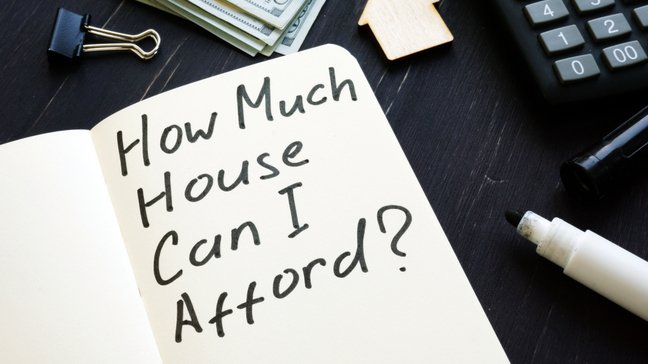Buying a home is a big life decision, but it’s also a massive investment.
It takes a long time — decades, in fact — to accrue enough savings to drop a few hundred thousand dollars on a property, and most of us don’t want to wait that long. This is where mortgage loans come in handy.
Especially for Millennials who are just beginning to build wealth, a mortgage loan makes the dream of owning a home tangible. Nevertheless, the process of obtaining a mortgage is complex and not one you should enter lightly.
Before you agree to monthly payments for the next 30 years, here’s everything you need to know about what a mortgage is, how much it costs, and which type may be right for you.
What’s Ahead:
- What is a mortgage?
- How do mortgage loans work?
- What is included in a mortgage payment?
- What are the different types of mortgage loans?
- How long does a mortgage typically last?
- How do I know which mortgage type is right for me?
- How do I know what price point I can afford?
- How can I get a mortgage?
- Where can I get a mortgage?
- Summary
What is a mortgage?

In short, a mortgage is a type of loan that’s used to finance a property. In other words, when you want to buy a house, but don’t have tons of cash lying around, a mortgage is your ticket to becoming a homeowner.
A mortgage is an agreement between a lender, generally a bank or credit union, and a borrower, like you. Together, you sign a contract, called a mortgage note, which outlines details like the amount of money to be loaned, the term length, the interest rate, and more. The mortgage note is your lender’s written agreement to loan you enough money to purchase a home and your agreement to pay it back. Until you’ve paid off your mortgage, the property belongs to the lender.
How do mortgage loans work?
Once you’ve found the perfect home and the right lender, your mortgage becomes another monthly payment, most likely for the next 15 or 30 years.
One way to pay off your loan faster is with a larger down payment. The down payment is the percentage of your overall loan that’s paid upfront, and most buyers pay between 3% and 20% of the total home price. The exact percentage depends, in part, on which mortgage type you’re applying for, but the higher your down payment, the less you owe and the less time you’ll spend repaying the loan.
Whether you can afford to pay just 5% upfront or 15%, your monthly mortgage payment should stay roughly the same throughout the duration of your loan. However, how much of that payment covers interest and how much goes towards your principal (the loan balance you owe before interest) will change over time. This is a process called amortization. Early on, much of your monthly payment will cover interest, but eventually, the percentage will shift and you’ll pay down more of the principal amount each month.
You’ll also need to pay for some additional expenses every month, like property taxes and homeowners insurance, which can fluctuate from year to year. Fortunately, many lenders set up what’s called an escrow account to manage these costs on your behalf.
Before your home becomes your home, escrow refers to a legal arrangement in which a third party temporarily holds your money until the sale has closed. But after the sale has ended, an escrow account may be set up, which allows the lender to hold borrower funds for the purpose of managing regular housing expenses, like taxes and insurance, on behalf of the borrower. Not every mortgage comes with an escrow account, but it is required for borrowers who pay a down payment lower than 20%.
Finally, since mortgage loans are a type of secured loan, you need an asset as collateral. In the case of a mortgage, your home is the collateral, so if you were to suddenly stop making payments to your lender, they could reclaim possession of the house. This process is called foreclosure.
What is included in a mortgage payment?

Principal
The principal is the big number. It’s the amount you, the borrower, owe the lender, and it decreases over time as you make monthly payments to repay the loan amount.
Interest
The interest is what your lender receives in exchange for loaning you money. It may be a set amount (fixed) or may change over the life of the loan (adjustable). The interest also depends on factors like the borrower’s credit score and income level, as well as current rates being offered at that time.
Property taxes
Property taxes are based on the assessed value of your home and are paid to local governments. Consequently, the amount you pay in property taxes depends on where you live, and the rate can be considerably higher in some areas than in others.
Homeowners insurance
Homeowners insurance exists to protect you and your home, specifically your home’s value, from circumstances beyond your control, referred to as perils. If there were a fire or theft, for instance, homeowners insurance is there to help you land on your feet and get back on track.
Homeowners insurance premiums vary based on a number of factors, from your home’s age and build quality to details like your credit score. Fortunately, you can use a site like Policygenius to shop around and compare homeowners insurance quotes from a number of leading providers.
Mortgage insurance
I know. We already talked about insurance. But, mortgage insurance is a special kind of insurance, which borrowers pay when their down payment is less than 20% of the loan value. This is to protect the lender in case the borrower were to stop making payments, and unlike homeowners insurance, the lender typically selects and sets your mortgage insurance premium.
There are two types of mortgage insurance: private mortgage insurance (PMI) and mortgage insurance premium (MIP). The former typically lasts until the borrower has built up a certain amount of equity in their home; the latter is specifically for government-backed loans (which I’ll discuss in the following section) and lasts through the life of the loan.
What are the different types of mortgage loans?
When it comes to types of mortgage loans, it’s easy to get confused.
You can categorize them by conventional or government-backed, fixed- or adjustable-rate, conforming or nonconforming, and so on; and if those categories aren’t enough to send your head spinning, they can also overlap.
To simplify these categories, I’ve focused on some of the most common types of mortgage loans below: 15-year and 30-year fixed-rate loans, jumbo loans, and FHA loans.
15-year and 30-year fixed-rate loans
One detail that’s applicable to all mortgages is the interest rate, and many loans fall under either a 15-year or 30-year fixed-rate mortgage. In this mortgage type, your rate remains fixed (no surprise there) through the duration of the loan, as opposed to an adjustable rate, which changes based on the housing market.
You may also hear these loans referred to as, for example, a 30-year fixed-rate conventional loan. This just means the loan is not insured by a government agency (I’ll touch on government-backed loans later). Conventional loans are the most popular mortgage type in the nation, with 69% of Americans purchasing homes in 2019 with conventional mortgages.
While fixed-rate loans remain consistent through the life of the loan, adjustable-rate (ARM) mortgages fluctuate over time, based on the market. However, most ARM loans begin with a fixed rate for a period of 3, 5, 7, or 10 years.
Jumbo loans
There are two types of conventional loans: conforming and non-conforming. Non-conforming loans do not meet standards set by the Federal Housing Finance Agency (FHFA), Freddie Mac, and/or Fannie Mae.
Jumbo loans are a type of non-conforming loan because they can provide borrowers with more money than the lending limit set by the FHFA.
For borrowers who need a hefty chunk of change, jumbo loans are an ideal solution. However, to offset the risk these lenders take on by loaning such large amounts, jumbo loans often come with high-interest rates and competitive eligibility requirements, such as high income and excellent credit.
FHA loans
FHA loans are a type of government-insured loan. More specifically, FHA loans are insured by the Federal Housing Administration (FHA), and they make home-buying a realistic pursuit for borrowers who don’t quite meet the qualifications necessary for conventional loans.
Like jumbo loans, FHA loans (and the government-insured options listed below) are non-conforming, because they do not adhere to standards set by the FHFA, Freddie Mac, and/or Fannie Mae. However, unlike jumbo loans, government-backed mortgages are not considered conventional. A conventional loan is not backed by a government entity, so the eligibility standards are much stricter.
For example, a conventional loan typically requires a credit score of 620 or higher. With an FHA loan, however, you can receive a mortgage with a credit score of 580 and sometimes as low as 500. Furthermore, conventional loans necessitate a down payment of 10%, but an FHA loan needs just 3.5%.
FHA loans are incredibly common among first-time homebuyers, especially those with low to moderate income.
How long does a mortgage typically last?

The length of your mortgage is referred to as the loan term, and terms are most commonly either 15 or 30 years. However, you can also get a mortgage for 5 years or even 40.
It’s important to keep in mind that the length of your loan term impacts two crucial factors of your mortgage: the monthly payment and the interest. The benefit of a shorter loan term is you’ll pay less in interest over time; the downside, however, is you’ll have a larger monthly payment. The opposite is true of longer loan terms: you’ll have a smaller monthly payment, but you’ll pay more over the life of the loan due to interest.
With this said, a lot of first-time homebuyers opt for a 30-year fixed-rate mortgage since it offers a lower monthly payment.
How do I know which mortgage type is right for me?
Each loan type caters to certain borrowers, such as low-income families or military members; however, you’ll also need to evaluate the eligibility requirements for each type to learn which is best for you.
When to use a VA loan
If you are a military service member, start your search with a VA loan. VA loans are designed to assist our military and consequently offer some pretty attractive perks. For instance, VA loans require a 0% down payment, 100% financing, and no monthly mortgage insurance premium. In addition to military service requirements, you’ll need a decent credit score, generally 620, and a low debt-to-income (DTI) ratio, typically 43% or less, to qualify for a VA loan.
When to use a USDA loan
If you are looking at properties in a rural area, consider a USDA loan. USDA loans are designed to assist low-income families, so your adjusted gross income cannot exceed 115% of the median income in your area. You will also need a debt-to-income (DTI) ratio of 50% or less as well as a credit score of 620 or higher. If you do qualify, however, USDA loans also require a 0% down payment (for most borrowers).
When to use a jumbo loan
If you need to borrow $548,250 or more, a jumbo loan is probably the way to go. However, keep in mind that jumbo loans have some of the strictest eligibility requirements of them all. Since you’re asking for such a large amount of money — too much, in fact, to be federally-insured — lenders typically require a credit score of 700 or higher, a DTI of 45% or less, a down payment of at least 10%, as well as significant assets.
When to use an FHA loan
After jumbo loans, conventional mortgages have some of the strictest qualifications, including a credit score of 620 and typically a down payment of 10% (although 3-5% down payments are available in certain circumstances).
FHA loans, on the other hand, are designed to make home-buying a more realistic endeavor for individuals with mediocre financial records. For instance, you can qualify for an FHA loan with a credit score of just 580 (or as low as 500 if you can afford a 10% down payment), and your down payment could be as low as 3.5%. Even borrowers who’ve filed for bankruptcy or foreclosure are eligible!
However, FHA loans have their drawbacks too. You will likely pay more over time with an FHA loan, with mortgage insurance payments lasting through the life of the loan. In addition, FHA loans will typically have higher closing costs and stricter inspection standards.
How do I know what price point I can afford?

To figure out just how much house you can afford, you need to know much your budget can handle on a monthly basis and how much extra debt you can take on.
Let’s start with your monthly payment. Most banks will approve a mortgage payment that’s 35% of your gross, pre-tax monthly income or less. However, to make sure your budget leaves room for unexpected expenses, many financial advisors recommend a cap of 28%, or 32% for the total monthly housing payment (including property taxes, homeowner’s insurance, fees, and such). For a couple that makes $80,000 annually, this would put their monthly mortgage payment at $1,866, and the total monthly housing payment at $2,133.
You also want to consider your current debt. With the mortgage payments included, your monthly debt payments should stay below a cap of 40% of your gross monthly income. This includes auto payments, student loans, credit card debt, and so on.
With all this said, there are a number of costs to consider when you’re preparing to purchase a home, from the interest rate to the initial down payment. To figure out what housing prices fit within your budget, take advantage of Money Under 30’s Home Affordability Calculator.
How can I get a mortgage?
The first step to acquiring your mortgage is to get pre-approved.
You can certainly calculate what kind of mortgage falls within your budget on your own, but you won’t know for sure what price range you qualify for without talking to lenders. During the pre-approval process, a lender reviews and verifies your information in order to tell you just how much you can borrow and, consequently, how much house you can buy.
Once you’ve been pre-approved, you’re free to hunt for a house, and the lender won’t step back on the scene until you’ve made an offer on a property and it’s been accepted. At this point, the real grunt work begins. Your lender needs to fully vet not only your own information — details regarding your income and assets, for instance — but also your home’s. You’ll typically bring in an appraiser to evaluate your home’s condition and verify its value, as well as a title company to review the home’s title for any potential barriers to the sale or future issues.
Lastly, it’s time to close the sale and finalize your loan! This is when you’ll pay the down payment, as well as any additional closing costs like inspection fees and the application fee, and sign all paperwork, including the mortgage note.
When all is signed and done, you’ve got your mortgage and your home!
Where can I get a mortgage?
Mortgage loans are available through credit unions, banks, and government entities like the VA and USDA. However, lenders vary in their qualifications, as well as their rates and terms.
To find the best mortgage rates in your area, check out the list of reputable lenders below:
Credible is the perfect place to start when looking for a mortgage since they let you compare multiple mortgage companies all in one place. After you take a few minutes to answer some basic questions about yourself and the loan you’re looking for, Credible will generate you a list of lenders and outline their rates and terms. You can pick whichever one fits into your budget the best.
Best of all, your credit score won’t be affected at all when you run your numbers through Credible. Oh yeah, did I mention Credible is also totally free to use?
Credible Operations, Inc. NMLS# 1681276, “Credible.” Not available in all states. www.nmlsconsumeraccess.org.” Credible Credit Disclosure - To check the rates and terms you qualify for, Credible or our partner lender(s) conduct a soft credit pull that will not affect your credit score. However, when you apply for credit, your full credit report from one or more consumer reporting agencies will be requested, which is considered a hard credit pull and will affect your credit.Summary
House hunting is a complicated process, so make sure you understand it well before committing to 15 or 30 years of monthly mortgage payments.
Before you start the search for your dream home, check out Money Under 30’s Home Affordability Calculator to make sure you know what kind of mortgage will work for your budget. You should also compare quotes from lenders and homeowners insurance providers to get a sense of the true cost of your home. Additionally, it’s important to remember buying a home includes a number of other costs, such as the down payment and closing costs as well as long-term expenses like property taxes and even mortgage insurance.
Once you’re apprised of all things mortgage, you can confidently begin shopping for your future home!


